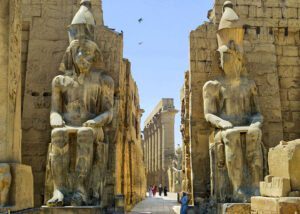The Medinet Habu Temple Luxor stands as a testament to the splendor of ancient Egypt. Built to honor Ramesses III, this majestic site offers visitors a rare glimpse into the religious, military, and cultural life of one of history’s most fascinating civilizations. This temple is not just a historical marvel but also a masterpiece of art and architecture.
In this guide, we will explore the history, architectural wonders, and cultural significance of the Medinet Habu Temple Luxor, while diving into the details of its construction, surroundings, and why it remains a must-visit destination for history and architecture enthusiasts.
The History of Medinet Habu Temple Luxor
Constructed during the reign of Ramesses III in the 12th century BCE, the Medinet Habu Temple Luxor served as both a mortuary temple and a political fortress. Officially called the Mortuary Temple of Ramesses III, it commemorates the pharaoh’s reign and his military victories, particularly his battles against the Sea Peoples.
Unlike many other temples, Medinet Habu Luxor was fortified, symbolizing Egypt’s strength against invaders. Its walls, adorned with vibrant carvings, tell tales of battles, rituals, and divine connections, making it a historical treasure trove.
Architectural Highlights of Medinet Habu Temple Luxor
The Medinet Habu Egypt Temple is renowned for its stunning architecture. Its grand design reflects the artistry and precision of ancient Egyptian builders.
1. The First Pylon
The temple’s massive entrance pylon features detailed carvings of Ramesses III’s military campaigns, providing an impressive welcome to visitors.
2. The Great Courtyard
This open space, surrounded by columns, was used for public ceremonies and gatherings. The walls of the courtyard display vibrant reliefs of religious rituals.
3. Hypostyle Hall
The hypostyle hall, with its towering columns, is a highlight of the Medinet Habu Building. The intricately decorated columns narrate scenes from religious texts and royal decrees.
4. The Royal Palace
Within the temple complex lies the Medinet Habu Palace, a unique feature that served as a residence for Ramesses III during significant ceremonies. The palace showcases the blend of practicality and grandeur in ancient Egyptian design.
5. Sacred Lake and Storage Rooms
The temple complex includes a sacred lake used for purification rituals and numerous storage rooms, which hint at its logistical and religious importance.
Where is Medinet Habu?
The Medinet Habu Temple Luxor Egypt is located on the west bank of the Nile River, near the Valley of the Kings. Its location places it among some of Luxor’s most iconic historical sites.
- Address: West Bank of Luxor, near the Colossi of Memnon
- How to Get There:
- By Taxi: A quick ride from central Luxor.
- By Guided Tour: Many tours include Medinet Habu as part of a west bank itinerary.
- By Bike: A scenic option for adventurous travelers.
Significance of Medinet Habu Luxor
The Medinet Habu Temple Luxor is much more than a historical site; it is a reflection of Egypt’s spiritual, political, and artistic achievements.
- Religious Significance: Dedicated to the god Amun and the deified Ramesses III, the temple was a center for worship and rituals.
- Cultural Importance: The intricate carvings and vibrant colors provide a deep insight into ancient Egyptian culture and artistry.
- Historical Value: The temple serves as a detailed record of Ramesses III’s reign, military victories, and religious practices.
Medinet Habu Rome and Cultural Influence
The influence of Medinet Habu Luxor extended beyond Egypt, inspiring architectural and artistic endeavors even in ancient Rome. This cultural bridge highlights the temple’s enduring legacy and its role in shaping world heritage.
Top Reasons to Visit Medinet Habu Temple Luxor
- Historical Exploration: The Mortuary Temple of Ramesses III is a rich source of historical narratives.
- Architectural Beauty: From the towering pylons to the intricate columns, every detail of the Medinet Habu Building amazes.
- Cultural Insight: Learn about ancient Egyptian rituals, beliefs, and daily life through the temple’s carvings.
- Photographic Opportunities: The well-preserved carvings and vibrant colors make for stunning photos.
FAQs About Medinet Habu Temple Luxor
1. Where is Medinet Habu located?
The temple is located on the west bank of the Nile in Luxor, near other iconic sites like the Valley of the Kings.
2. What is unique about the Medinet Habu Palace?
The Medinet Habu Palace is an integral part of the temple complex, showcasing the blend of royal residence and religious significance.
3. Why is the temple called the Mortuary Temple of Ramesses III?
It served as a place to honor and commemorate the life and achievements of Ramesses III, ensuring his legacy in the afterlife.
Nearby Attractions
While visiting Medinet Habu Temple Luxor, don’t miss these nearby landmarks:
- Valley of the Kings: Explore the tombs of ancient pharaohs.
- Hatshepsut’s Temple: A stunning example of New Kingdom architecture.
- Colossi of Memnon: Iconic statues that stand as guardians of the west bank.
- Deir el-Medina: A well-preserved workers’ village offering insights into ancient Egyptian daily life.
Tips for Visiting Medinet Habu Temple Luxor
- Hire a Guide: Gain deeper insights into the temple’s history and significance.
- Arrive Early: Beat the crowds and explore in cooler temperatures.
- Bring Essentials: Water, sunscreen, and comfortable shoes are a must.
- Respect the Site: Avoid touching carvings and adhere to visitor guidelines.
Is Medinet Habu Temple Luxor Worth Visiting?
Absolutely! The Medinet Habu Temple Luxor Egypt is a treasure trove of history, art, and culture. Its well-preserved structures and vivid carvings make it a standout destination for anyone exploring Luxor.
Whether you’re a history enthusiast or a curious traveler, this temple promises an unforgettable experience, connecting you to the grandeur of ancient Egypt.
Conclusion
The Medinet Habu Temple Luxor is a marvel that encapsulates the glory of ancient Egypt. From its architectural brilliance to its historical narratives, this site offers a profound journey into the past. Don’t miss the chance to explore the Medinet Habu Egypt Temple and immerse yourself in its timeless beauty.
Plan your visit to Medinet Habu Luxor and witness one of the greatest legacies of the New Kingdom era!
Related :




